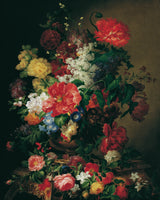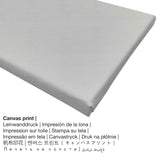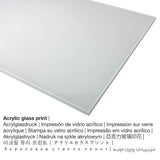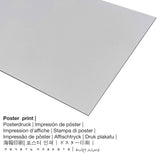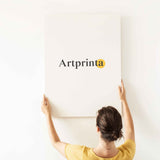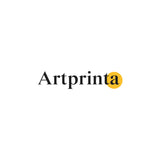Josef Nigg, 1835 - ụyọkọ okooko osisi - ọmarịcha nka
Ụtụ gụnyere. Mbupu gbakọrọ na ndenye ọpụpụ.
Akụrụngwa ị nwere ike iburu
Nchịkọta nhọrọ ngwaahịa na-enye gị ohere ịhọrọ nha na ihe ị họọrọ. Nhọrọ ndị a dị maka n'otu n'otu:
- Aluminom dibond mbipụta (ọla): An Aluminium Dibond print is a print with a true depth effect. For the Print On Aluminum Dibond, we print your favorite artwork right on the surface of the aluminum.
- Akwụkwọ mmado ebipụtara (akwa akwa akwa): The poster is a printed flat canvas with a slight surface finish, which resembles the original version of the work of art. Please note, that depending on the absolute size of the canvas poster print we add a white margin between 2-6cm around the work of art, which facilitates the framing with your custom frame.
- Bipụta na iko acrylic na-egbuke egbuke (nke nwere ezigbo mkpuchi iko): A glossy acrylic glass print, often named a plexiglass print, transforms your favorite original work of art into wonderful home decoration. In addition, it offers a great alternative option to dibond or canvas fine art replicas. Your favorite work of art is being custom-made with state-of-the-art UV direct printing machines. With an acrylic glass fine art print contrasts and minor details will be more visible with the help of the fine tonal gradation in the print.
- Mbipụta kanvas: A UV printed canvas material applied on a wood stretcher frame. Canvas Prints have the advantage of being low in weight, which means that it is easy and straightforward to hang your Canvas print without the support of extra wall-mounts. Canvas prints are suitable for all types of walls.
Important note: We try everything in order to depict the products as accurately as possible and to display them visually in our shop. Please keep in mind that the colors of the print materials and the print result may differ to a certain extent from the image on the screen. Depending on the settings of your screen and the quality of the surface, color pigments might not be printed as exactly as the digital version shown here. In view of the fact that all the fine art prints are processed and printed by hand, there might as well be slight variations in the exact position and the size of the motif.
Nkọwa ihe osise sitere na Belvedere (© Nwebiisinka - Belvedere - www.belvedere.at)
After studying at the Vienna Academy of Fine Arts under Johann Baptist Drechsler (1756-1811) Josef Nigg from 1800 until his retirement in 1843 at the Vienna Porcelain Manufactory was working. From 1816 he had as chief painter overseeing all employed there flower painter. In addition to the flower pieces of porcelain vases and plates painted Nigg, which include many arrangements in oil, watercolor and pastel art of the most important works of this genre in Vienna. Together with Drechsler, Sebastian Wegmayr (1778-1857), Franz Xaver Gruber (1801-1862) and Franz Xaver Petter (1791-1866), he established the important works of Dutch and Flemish masters of the 17th and 18th century, the are the basic roots of floral painting Biedermeier. Since the development of this art form was based above all a fashionable need and a growing demand, they do not unfolded to free artistic laws but took over in the first place proven formulas. This is for example read on the presentation of the bouquet before a shaded background, the draping of the plants around the base of the vase, the inclusion of items of daily use (the small table from the 18th century), as well as the targeted use of lighting. Works of Jan van Huysum (1682-1749), Willem van Aelst (1626-1683) or Rachel Ruysch (1664-1750) were the painters from the Academy Gallery, as well as from various private collections known and familiar. They served as inspiration for the fantasy that combine the most beautiful flowers entirely different flowering time and origin. That scientific accuracy only played a minor role, is covered by the artistry of the Arrangement and the great fidelity of individual flowers. But that public taste was exactly satisfied by decorative motifs. Literature: Mrazek, W .: Josef Nigg. A Viennese painter of flowers, in: Old and Modern Art, Vol 1, No. 2, 1956, pp 2-5;.. Dossi, B .: The development of the Wiener Blumenstilleben life of 1780-1850 while taking into account literary currents, Diss. Phil. (Unpublished), Vienna, 1982; A bouquet for Waldmüller. Still life Ferdinand Georg Waldmüller and his time, Edit. v. Stephan Koja, exh. Cat. Osterreichische Galerie Belvedere, Vienna 1993. [Sabine Grabner, in that this .: romanticism, classicism, Biedermeier. In the Austrian Gallery Belvedere, the second verb. Ed. Vienna 1997, p 88-89]
Interesting facts about the painting from Josef Nigg
This over 180 years old artpiece was created by Josef Nigg in 1835. The mbụ version e ese na size nke 80 x 64 cm - akụkụ etiti: 98 x 81 x 7 cm e jikwa ya see ya mmanụ na kwaaji. "Signed lower right: Jos: Nigg." was the artpiece's original inscription. Nowadays, the artpiece is included in the Belvedere's digital art collection, which is located in Vienna, Austria. Site n'ikike nke © Belvedere, Vienna, nọmba ngwa ahịa: 3630 (ikike ngalaba ọha). : nyefee site na Kunsthistorisches Museum, Vienna. - 1939 ngwaahịa na 1921. On top of that, alignment is in portrait format with an aspect ratio of 1: 1.2, nke pụtara na ogologo bụ 20% mkpụmkpụ karịa obosara. The painter Josef Nigg was an artist, whose style can primarily be classified as Realism. The painter was born in the year 1782 na Vienna ma nwụọ mgbe ọ dị afọ 81 n'afọ 1863.
Ozi nka ahaziri
| Aha ọrụ nka: | "Ụyọkọ okooko osisi" |
| nhazi ọkwa: | sere |
| Okwu nche anwụ: | nkà nke oge a |
| Nhazi oge: | 19th narị afọ |
| Emepụtara n'afọ: | 1835 |
| Ogologo afọ nka nka: | karịa afọ 180 |
| Ọkara nke ihe osise izizi: | mmanụ na kwaaji |
| Nha izizi: | 80 x 64 cm - akụkụ etiti: 98 x 81 x 7 cm |
| Ederede ihe osise izizi: | signed lower right: Jos: Nigg. |
| Ụlọ ihe ngosi nka / mkpokọta: | Belvedere |
| Ebe ngosi nka: | Vienna, Austria |
| Weebụsaịtị nke ihe ngosi nka: | www.belvedere.at |
| License: | ngalaba ọha |
| Site n'aka: | © Belvedere, Vienna, nọmba ngwa ahịa: 3630 |
| Ebe E Si Nweta: | nyefee site na Kunsthistorisches Museum, Vienna. - 1939 ngwaahịa na 1921 |
Ngwaahịa a
| Ụdị edemede: | nka nka |
| Usoro mmeghari: | dijitalụ mmeputakwa |
| Production usoro: | Mbipụta UV ozugbo (mbipụta dijitalụ) |
| Mmalite ngwaahịa: | Germany |
| Ụdị ngwaahịa: | na mmepụta ihe |
| Eji ngwaahịa a chọrọ: | ihe ndozi mgbidi, mgbidi gallery |
| Nhazi: | usoro eserese |
| Oke akụkụ: | 1: 1.2 (ogologo: obosara) |
| Mmetụta akụkụ onyonyo: | ogologo bụ 20% mkpụmkpụ karịa obosara |
| Ụdị dị iche iche dị: | Mpempe akwụkwọ, akwụkwọ mmado (akwụkwọ akpa), mbipụta enyo acrylic (nwere ezigbo mkpuchi iko), mbipụta ọla (aluminium dibbond) |
| Nhọrọ nke Canvas Mbipụta (akwa akwa na etiti ihe ndọtị): | 50x60cm - 20x24", 100x120cm - 39x47", 150x180cm - 59x71" |
| Mbipụta iko acrylic (nwere ezigbo mkpuchi iko) nhọrọ nha: | 50x60cm - 20x24", 100x120cm - 39x47" |
| Mbipụta akwụkwọ mmado (akwụkwọ kwaaji): | 50x60cm - 20x24", 100x120cm - 39x47" |
| Nhọrọ nha nha nke aluminom dibond (ihe aluminom): | 50x60cm - 20x24", 100x120cm - 39x47" |
| Igwe onyonyo: | adịghị |
Ozi omenkà Contextal
| Aha onye nka: | Josef Nigg |
| Ọrụ: | onye na-ese ihe |
| nhazi ọkwa: | omenkà nke oge a |
| Ụdị nka: | Ihe ngosi |
| Nwụrụ anwụ: | 81 afọ |
| Afọ ọmụmụ: | 1782 |
| Obodo amụrụ: | Vienna |
| Nwụrụ n'afọ: | 1863 |
| Obodo ọnwụ: | Vienna |
Nwebiisinka © | Artprinta.com (Artprinta)

